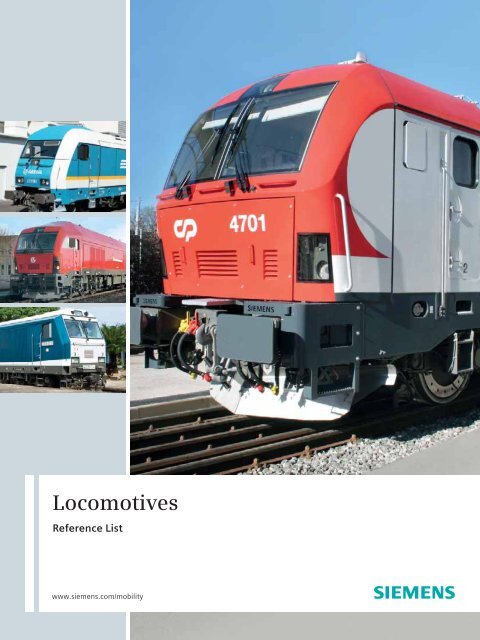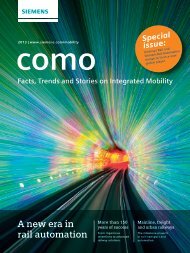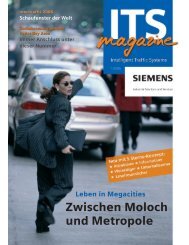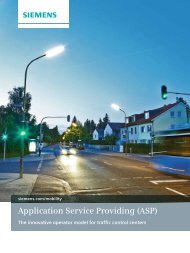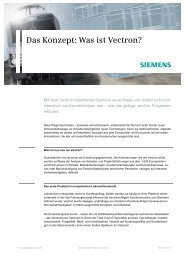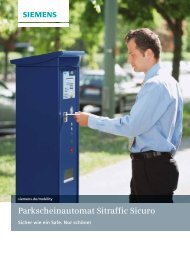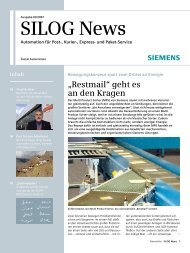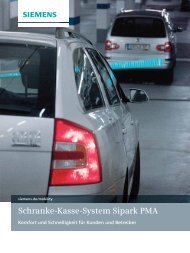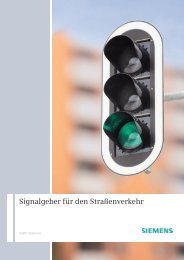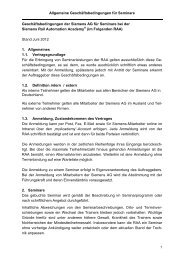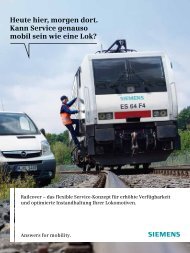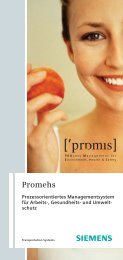Locomotives Reference List - Siemens Mobility
Locomotives Reference List - Siemens Mobility
Locomotives Reference List - Siemens Mobility
Create successful ePaper yourself
Turn your PDF publications into a flip-book with our unique Google optimized e-Paper software.
<strong>Locomotives</strong><br />
<strong>Reference</strong> <strong>List</strong><br />
www.siemens.com/mobility
2<br />
Content<br />
Eurosprinter<br />
HLE 18 Belgian State Railways 6<br />
LE 4700 Portuguese Railways 7<br />
HXd1 Chinese Railways 8<br />
Rh 1216 Austrian Federal Railways 9<br />
183 Vogtlandbahn GmbH 10<br />
Rh 1216 RTS Transport Service GmbH 10<br />
SZ 541 Slovenian State Railways 11<br />
Class 189 Railion Deutschland AG 12<br />
ES64F4/ES64F1 DC Mitsui Rail Capital Europe 13<br />
E 474 Del Fungo Giera 13<br />
441 Hector Rail AB 14<br />
Re 474 Swiss Federal Railways Cargo 14<br />
ES64F4 Dispolok GmbH 15<br />
Rh 1016 / 1116 Austrian Federal Railways 16<br />
1116 Mittelweserbahn GmbH 16<br />
1047 Hungarian State Railways and Raab-Oedenburg-Ebenfurter-Eisenbahn 17<br />
1116 HUPAC AG 17<br />
ES64U2 Dispolok GmbH 18<br />
Class 182 Railion Deutschland AG 18<br />
Class 152 Railion Deutschland AG 19<br />
DJ 1 Chinese Railways 19<br />
ES64F Dispolok GmbH 20<br />
8100 / 8200 Korean National Railroad 20<br />
120 Greek State Railways 21<br />
EG 3100 Railion Denmark A / S 21<br />
S 252 Spanish National Railways 22<br />
LE 5600 Portuguese Railways 23<br />
Eurorunner<br />
ER20CF Lithuanian Railways 24<br />
Rh 2016 Austrian Federal Railways 25<br />
270081 Osthannoversche Eisenbahnen AG 26<br />
223 Regentalbahn AG 26<br />
22 Westfälische Landes-Eisenbahn GmbH 26<br />
DE 2000 Veolia Verkehr GmbH 27<br />
420 Eisenbahnen und Verkehrsbetriebe Elbe-Weser GmbH 27<br />
2016 Steiermärkische Landesbahn 27<br />
2016 LTE Logistik- und Transport GmbH 27<br />
253 Eisenbahn-Bau- und Betriebsgesellschaft Pressnitztalbahn mbH 28<br />
ER20 Dispolok GmbH 28<br />
Series 8000 Kowloon-Canton Railways Corporation Hong Kong 28<br />
Issue: June 2008
Asiarunner<br />
AR15 VR Vietnam Railway 29<br />
Electric <strong>Locomotives</strong><br />
3800 Class Queensland Rail 30<br />
Locomotive Equipment and Cooperations<br />
3700 Class Queensland Rail 31<br />
R156 New York City Transit 32<br />
BB 475000 French National Railways 33<br />
O’zbekiston Uzbek Railway Company 34<br />
DS3 Ukrainian State Railways 34<br />
GT 42 CUAC Pacific National 35<br />
GT 42 CUAC Queensland Rail 35<br />
WDG4 / WDP4 and GT 46 MAC / PAC Indian Railways 36<br />
SD 90 MAC Phase 2 Canadian Pacific and Union Pacific 37<br />
SD 90 MAC Commercial Investment Trust 37<br />
SD 70 MAC Transportación Ferroviarie Mexicana 38<br />
SD 70 MAC / HEP Alaska Railroad 38<br />
SD 90 MAC Canadian Pacific 39<br />
SD 70 MAC CSX Transportation 39<br />
SD 90 MAC Union Pacific 40<br />
SD 80 MAC Conrail 40<br />
SD 70 MAC Burlington Northern Santa Fé 41<br />
Dual-Mode <strong>Locomotives</strong><br />
Class 38 South African Railways Spoornet 42<br />
DE 30 AC / DM 30 AC Long Island Rail Road 42<br />
Eurosprinter®, Eurorunner®, Asiarunner® and Sibas® are registered trade marks of <strong>Siemens</strong> AG.<br />
3
4<br />
Successful locomotive concepts for cost-effective and environmentally<br />
compatible rail operations<br />
All around the world, locomotives made by <strong>Siemens</strong> take passengers and<br />
freight to their destinations both quickly and safely. Since Werner von <strong>Siemens</strong><br />
presented the world’s first electric locomotive in Berlin in 1879, his name<br />
has been a symbol of quality and reliability. Leveraging the experience that<br />
has grown from this tradition, we have consistently built up our competence<br />
in the field of electric and diesel-electric locomotives. This expertise<br />
offers our customers maximum cost-efficiency from the very beginning<br />
through optimum and sustained availability.<br />
<strong>Mobility</strong> is unthinkable without flexibility. Therefore, the bandwidth of our<br />
products enables a comprehensive service, adapted to a wide variety of<br />
customer requirements. On a worldwide scale, we supply locomotives and<br />
propulsion technology for high-speed passenger service as well as for<br />
heavy-duty freight service for any power system.<br />
Successful locomotives and vehicle concepts, such as those of the Eurosprinter®<br />
family introduced in 1993, are constantly being developed.<br />
Today, more than 1,400 Eurosprinter are providing safe transportation in<br />
15 countries. Our multi-system compatible family members make a key
contribution to the opening up of the European railway system. Only<br />
recently, for example, has the Eurosprinter been put into operation in<br />
the Portuguese broad-gauge network.<br />
And the fact that a Class 1216 Eurosprinter of Austrian Federal Railways<br />
set the new speed world record at 357 km/h on September 2, 2006 is<br />
further proof of the quality and performance of <strong>Siemens</strong> locomotives.<br />
For the rail traffic of tomorrow, we develop advanced platforms such as<br />
the Eurorunner® and the Asiarunner®. Die Eurorunner is now considered<br />
the most environmentally compatible diesel locomotive and underscores<br />
our responsibility and the continuity of our innovative technology.<br />
We developed the light Asiarunner especially for the markets of Asia,<br />
South Africa and Australia. It is designed for operation on narrow-gauge<br />
tracks, caters to a wide variety of clearance envelopes and meets the<br />
requirement of low axle loads.<br />
The <strong>Siemens</strong> name guarantees the continuous optimization of this<br />
versatility and also the high level of quality we offer, thereby ensuring<br />
our customers’ success.<br />
5
6<br />
Eurosprinter<br />
Three-System Universal Locomotive HLE 18<br />
for Belgian State Railways SNCB / NMBS<br />
Scope of application<br />
The locomotives are designed for passenger service.<br />
They will partly substitute existing locomotives or be<br />
used to create additional capacity in the Belgian railway<br />
networks. It is also planned to obtain the certification<br />
for operation in the networks of neighboring<br />
countries so that the units may also be used for<br />
cross-border service.<br />
Technical features<br />
This is a four-axle multi-system locomotive built on<br />
the Eurosprinter platform.<br />
Type HLE 18<br />
Year 2009 – 2010<br />
Wheel arrangement Bo‘Bo‘<br />
Power system AC 25 kV / 50 Hz;<br />
DC 3 kV; DC 1.5 kV<br />
Rating [kW] 5,000;<br />
DC 1.5 kV 3,000<br />
Starting tractive effort [kN] 300<br />
Maximum speed [km/h] 200<br />
Weight [t] 88<br />
Track gauge [mm] 1,435<br />
Numbers built 60<br />
In December 2006, <strong>Siemens</strong> won the first order for electric locomotives from<br />
the state-owned railway operator SNCB / NMBS. The order comprised a total of<br />
60 locomotives, with an option for an additional 60 locomotives. The vehicles<br />
are being built in the <strong>Siemens</strong> locomotive plant in Munich. The units will be<br />
delivered between 2009 and June 2010.<br />
Benefits<br />
The Eurosprinter HLE 18 runs at a maximum speed<br />
of 200 km/h and can operate on conventional as<br />
well as high speed lines. The characteristic feature<br />
of these advanced locomotives is their multi-system<br />
capability that permits cross-border traffic.
Universal Locomotive LE 4700<br />
for Portuguese Railways CP<br />
In January 2006, Portuguese Railways CP ordered 15 electric locomotives from <strong>Siemens</strong>.<br />
The locomotives with the class designation LE 4700 are based on the Eurosprinter<br />
platform and were designed for the Portuguese broad-gauge network. An option<br />
for a further 10 vehicles was exercised in July 2007.<br />
Scope of application<br />
The 4,600 kW powerful vehicles are designed for use<br />
both in passenger and freight traffic and are equipped<br />
for future conversion to the European standard<br />
gauges.<br />
Technical features<br />
Locomotive body and the driver’s cab were designed<br />
according to current European legislation pertaining<br />
to TSI crash standards. Key parts of the drive and<br />
braking systems are of redundant design and can be<br />
partially switched off to ensure operability of the<br />
unit even in the case of a fault. The locomotive is<br />
designed for operation in Southern Europe at temperatures<br />
up to +45 °C. In addition to the diagnostics<br />
displays and an analog operating state display, the<br />
locomotive is equipped with country-specific train<br />
control systems (CONVEL), a train radio system and<br />
operations control systems.<br />
Type LE 4700<br />
Year 2007 – 2009<br />
Wheel arrangement Bo‘Bo‘<br />
Power system 25 kV / 50 Hz<br />
Rating [kW] 4,600<br />
Starting tractive effort [kN] 300<br />
Maximum speed [km/h] 140<br />
Weight [t] 87<br />
Track gauge [mm] 1,668 / 1,435<br />
Numbers built 25<br />
Benefits<br />
Thanks to a wheelset exchange feature, the newly<br />
developed bogies allow simple adaptation to both<br />
track gauges used in Portugal, i.e. standard gauge<br />
and broad gauge. The vehicles replace old vehicles<br />
in the Portuguese fleet, thereby increasing the<br />
operator’s efficiency and effectiveness.<br />
Eurosprinter<br />
7
8<br />
Eurosprinter<br />
Electric Double Locomotive HXd1<br />
for Chinese Railways CR<br />
In December 2004, <strong>Siemens</strong> and its partner CSR Zhuzhou Electric <strong>Locomotives</strong><br />
Company Ltd. received an order for 180 double locomotives from the Chinese<br />
Ministry of Railways, with the vehicles to be built by the Chinese partner in China.<br />
Scope of application<br />
The double locomotives that run at a maximum<br />
speed of 120 km/h are used in heavy-duty freight<br />
traffic, especially to haul coal trains along the<br />
620 km line between Datong and Qinhuangdao.<br />
Technical features<br />
This locomotive is the successor of the 20 double<br />
locomotives DJ1 that were delivered in 2002 and<br />
2003 and have proven their value through their<br />
reliability and performance in daily service.<br />
Type HXd1<br />
Year 2006 – 2007<br />
Wheel arrangement 2 (Bo‘Bo‘)<br />
Power system 25 kV / 50 Hz<br />
Rating [kW] 9,600<br />
Starting tractive effort [kN] 760<br />
Maximum speed [km/h] 120<br />
Weight [t] 2 x 92 (100)<br />
Track gauge [mm] 1,435<br />
Numbers built 180<br />
Benefits<br />
Thanks to their advanced technology, these locomotives,<br />
which were specially designed to haul coal trains,<br />
make a considerable contribution to the reduction of<br />
the energy consumption while increasing the transport<br />
capacity.
Three-System High-Performance Locomotive Rh 1216<br />
for Austrian Federal Railways ÖBB<br />
In 2003, Austrian Federal Railways ordered a design modification of the Rh 1116<br />
that has been available since 1997. The purpose was to extend the scope of application<br />
of the universal high-performance locomotives for the European 3 kV network<br />
such as exists, for example, in Italy. The three-system locomotive Rh 1216, which<br />
has its own class designation, is thus a logical consequence of ÖBB’s Taurus family,<br />
following the single- and two-system variants Rh 1016 and Rh 1116.<br />
Scope of application<br />
The Rh 1216 locomotive is suitable for use in national<br />
and international passenger and freight operations.<br />
The locomotive was designed to operate on the<br />
15 kV / 16.7 Hz, 25 kV / 50 Hz and 3 kV / DC electrified<br />
lines up to 230 km/h. It is thus a perfect solution for<br />
the entire European standard gauge network.<br />
In addition, it can run – with reduced power – in the<br />
1.5 kV / DC electrified network of the Netherlands<br />
and in the south of France.<br />
Technical features<br />
Based on the technical modifications, the vehicle<br />
represents another evolutionary step of the Eurosprinter<br />
family and combines the proven components<br />
of the Rh 1116 with the multi-system functionality<br />
of the third-generation Eurosprinter. For example,<br />
the quiet and low-maintenance high-performance<br />
drive system with separate brake disk shaft is complemented<br />
with water-cooled IGBT inverters and the<br />
Sibas 32 control system. The Rh 1216 uses the same<br />
aerodynamic Taurus design as the Rh 1016 / 1116.<br />
Type Rh 1216<br />
Year 2005 – 2007<br />
Wheel arrangement Bo’Bo’<br />
Power system AC 15 kV / 16.7 Hz;<br />
AC 25 kV / 50 Hz;<br />
DC 3 kV<br />
Rating [kW] 6,000<br />
Starting tractive effort [kN] 304<br />
Maximum speed [km/h] 230<br />
Weight [t] 87<br />
Track gauge [mm] 1,435<br />
Numbers built 50<br />
Benefits<br />
The Rh 1216 is the first European AC / DC-capable,<br />
high-speed, high-performance locomotive. It will<br />
initially operate in Austria, Germany, Italy, the<br />
Czech Republic, the Slovak Republic and Slovenia.<br />
Upon customers‘ request, additional country packages<br />
can be implemented for Hungary, Croatia, Poland,<br />
Switzerland and other European countries.<br />
Eurosprinter<br />
9
10<br />
Eurosprinter<br />
High-Performance Locomotive 183<br />
for Vogtlandbahn GmbH<br />
In January 2007, <strong>Siemens</strong> received its first electric locomotive order from Vogtlandbahn, a subsidiary<br />
of Länderbahn. The order comprises four Eurosprinter locomotives that were delivered as early as<br />
November 2007. Running at up to 230 km/h, the vehicles will be used in passenger service, e.g. on<br />
the Regensburg – Munich line. The proven technology of the production locomotives and the short<br />
delivery times were decisive factors for winning the order.<br />
Three-System High-Performance Locomotive Rh 1216<br />
for RTS Transport Service GmbH<br />
Type 183<br />
Year 2007<br />
Wheel arrangement Bo‘Bo‘<br />
Power system AC 15 kV / 16.7 Hz;<br />
Rating [kW] 6,000<br />
Starting tractive effort [kN] 304<br />
Maximum speed [km/h] 230<br />
Weight [t] 87<br />
Track gauge [mm] 1,435<br />
Numbers built 4<br />
Type Rh 1216<br />
Year 2007<br />
Wheel arrangement Bo’Bo’<br />
Power system AC 15 kV / 16.7 Hz;<br />
AC 25 kV / 50 Hz;<br />
DC 3 kV<br />
Rating [kW] 6,000<br />
Starting tractive effort [kN] 304<br />
Maximum speed [km/h] 230<br />
Weight [t] 87<br />
Track gauge [mm] 1,435<br />
Numbers built 2<br />
As the first private railway operator in Austria, RTS Rail Transport Service GmbH ordered two four-system<br />
high-performance locomotives in December 2006. The vehicles are primarily used to haul slag trains<br />
between Linz steelworks and the cement plant in Lorüns. Another application is the shuttling of work trains.<br />
RTS selected the <strong>Siemens</strong> locomotives due to the short delivery time of four months, the existing certifications<br />
and the widespread maintenance facilities in Austria.
Three-System High-Performance Locomotive SZ 541<br />
for Slovenian State Railways SZ<br />
Type SZ 541<br />
Year 2005 – 2007<br />
Wheel arrangement Bo‘Bo‘<br />
Power system AC 15 kV / 16.7 Hz;<br />
AC 25 kV / 50 Hz;<br />
DC 3 kV<br />
Rating [kW] 6,000<br />
Starting tractive effort [kN] 304<br />
Maximum speed [km/h] 230<br />
Weight [t] 87<br />
Track gauge [mm] 1,435<br />
Numbers built 32<br />
Slovenian State Railways SZ placed an order in July 2004 for 20 three-system locomotives based on the Eurosprinter<br />
family and exercised an option for another 12 vehicles in January 2008. SZ is the second customer<br />
after Austrian Federal Railways to decide in favor of this locomotive platform. The Class SZ 541 is suitable for<br />
operation in both national and international passenger and freight sectors. It is to be deployed in Slovenia,<br />
Germany, Italy, Croatia, Austria and Hungary. In addition, service in other countries (e.g. the Czech Republic,<br />
Slovak Republic) is also technically possible.<br />
Eurosprinter<br />
11
12<br />
Eurosprinter<br />
Class 189 Four-System High-Performance Locomotive<br />
for Railion Deutschland AG<br />
In 1999, Railion Deutschland AG ordered 100 Class 189 four-system locomotives<br />
for freight operations. These were developed directly from the Class 152 and form<br />
the multi-system platform of the Eurosprinter family.<br />
Scope of application<br />
The locomotives are designed for use in cross-border<br />
freight operations. They are able to operate not only<br />
in AC systems with 15 kV / 16.7 Hz and 25 kV / 50 Hz<br />
but also in DC systems with 1.5 kV and 3 kV.<br />
Technical features<br />
The Class 189 provides individual axle control and<br />
achieves a maximum speed of 140 km/h. In AC<br />
systems, the DC link voltage is generated by fourquadrant<br />
choppers. In DC systems, the overhead line<br />
voltage is fed directly to the DC link. The use of<br />
water-cooled high voltage IGBT traction converters<br />
(6.5 kV) marks the transition to the third generation<br />
of the Eurosprinter family. The controls of the<br />
Class 189 locomotive are designed in conformance<br />
with the other vehicles German Rail plans to use for<br />
its cross-border services.<br />
In compliance with the scope of application of a<br />
freight locomotive, the bogies are equipped with<br />
nose-suspended drives and disc brakes.<br />
Type Class 189<br />
Year 2003 – 2005<br />
Wheel arrangement Bo‘Bo‘<br />
Power system AC 15 kV / 16.7 Hz;<br />
AC 25 kV / 50 Hz;<br />
DC 3 kV; DC 1.5 kV<br />
Rating [kW] AC 6,400;<br />
DC 3 kV 6,000;<br />
DC 1.5 kV 4,200<br />
Starting tractive effort [kN] 300<br />
Maximum speed [km/h] 140<br />
Weight [t] 86<br />
Track gauge [mm] 1,435<br />
Numbers built 100<br />
Benefits<br />
This locomotive type will be provided with all the<br />
equipment required for operation in the other European<br />
countries. The locomotives will be prepared for<br />
homologation in Germany, Austria, Hungary, Switzerland,<br />
Denmark, Sweden, Norway, Italy, France, the<br />
Netherlands, Luxembourg, Belgium, Poland, the<br />
Czech Republic, and the Slovak Republic.
Multi-system High-Performance Locomotive<br />
ES64F4/ES64F1 DC<br />
für Mitsui Rail Capital Europe MRCE<br />
In September 2006, Mitsui Rail Capital Europe ordered 50 Eurosprinter multi-system locomotives. 30 foursystem<br />
units will operate in different corridors. 20 more locomotives will be delivered as DC 3 kV versions<br />
and are designed for operation in Poland or in Poland and Italy. The Eurosprinter platform and the operating<br />
experience with numerous European customers made it possible to leverage a successful and proven platform<br />
approach that can be extended by additional homologations in Europe.<br />
Two-System Locomotive E 474<br />
for Del Fungo Giera DFG<br />
Eurosprinter<br />
Type ES64F4 ES64F1 DC<br />
Year 2007 – 2009 2007 – 2009<br />
Wheel arrangement Bo‘Bo‘ Bo‘Bo‘<br />
Power system AC 15 kV / 16.7 Hz;<br />
AC 25 kV / 50 Hz;<br />
DC 3 kV;<br />
DC 1.5 kV<br />
DC 3 kV<br />
Rating [kW] AC 6,400;<br />
DC 3 kV 6,000;<br />
DC 1.5 kV 4,200<br />
6,000<br />
Starting tractive effort [kN] 300 300<br />
Maximum speed [km/h] 140 140<br />
Weight [t] 87 87<br />
Track gauge [mm] 1,435 1,435<br />
Numbers built 30 20<br />
Type E 474<br />
Year 2007<br />
Wheel arrangement Bo‘Bo‘<br />
Power system AC 15 kV / 16.7 Hz;<br />
DC 3 kV<br />
Rating [kW] AC 6,400;<br />
DC 3 kV 6,000<br />
Starting tractive effort [kN] 300<br />
Maximum speed [km/h] 140<br />
Weight [t] 87<br />
Track gauge [mm] 1,435<br />
Numbers built 4<br />
<strong>Siemens</strong> will deliver four E 474 multi-system locomotives to the Italian railway operator Del Fungo Giera.<br />
The Eurosprinter locomotives are certified for Italy and Switzerland where they will be used primarily in freight<br />
traffic. This extends the capacity for the customer and more cost-effective operations in cross-border freight<br />
traffic.<br />
13
14<br />
Eurosprinter<br />
Three-System High-Performance Locomotive 441<br />
for Hector Rail AB<br />
Type 441<br />
Year 2005<br />
Wheel arrangement Bo‘Bo‘<br />
Power system AC 15 kV / 16.7 Hz;<br />
AC 25 kV / 50 Hz;<br />
DC 3 kV<br />
Rating [kW] 6,400<br />
Starting tractive effort [kN] 300<br />
Maximum speed [km/h] 140<br />
Weight [t] 86<br />
Track gauge [mm] 1,435<br />
Numbers built 2<br />
In November 2005, the Swedish private rail company Hector Rail AB ordered two multi-system Eurosprinter.<br />
This makes Hector Rail the first operator in Sweden to own modern electric locomotives to increase the performance<br />
capability of its fleet. The locomotives will be used on a 1,100-km-long line which stretches from<br />
central to northern Sweden. The topographically demanding route requires high utilization of the tractive<br />
effort as well as high operational availability. The low-maintenance drive concept and the high level of energy<br />
recovery contribute to a substantial reduction in operating costs.<br />
Two-System High-Performance Locomotive Re 474<br />
for Swiss Federal Railways SBB Cargo<br />
Type Re 474<br />
Year 2004 – 2005<br />
Wheel arrangement Bo‘Bo‘<br />
Power system AC 15 kV / 16.7 Hz; DC 3 kV<br />
Rating [kW] AC 6,400;<br />
DC 3 kV 6,000<br />
Starting tractive effort [kN] 300<br />
Maximum speed [km/h] 140<br />
Weight [t] 87<br />
Track gauge [mm] 1,435<br />
Numbers built 12<br />
Swiss Federal Railways SBB Cargo ordered 12 Eurosprinter type two-system locomotives from <strong>Siemens</strong> in<br />
December 2003. These Re 474s are being used in cross-border freight traffic between Switzerland and Italy.<br />
The Re 474 has a Swiss and Italian homologation. For the operator, this means an optimization of operations<br />
and increased economic efficiency in cross-border service.
Four-System High-Performance Locomotive ES64F4<br />
for Dispolok GmbH<br />
Type ES64F4<br />
Year 2003 – 2006<br />
Wheel arrangement Bo’Bo’<br />
Power system AC 15 kV / 16.7 Hz;<br />
AC 25 kV / 50 Hz;<br />
DC 3 kV; DC 1.5 kV<br />
Rating [kW] AC 6,400;<br />
DC 3 kV 6,000;<br />
DC 1.5 kV 4,200<br />
Starting tractive effort [kN] 300<br />
Maximum speed [km/h] 140<br />
Weight [t] 87<br />
Track gauge [mm] 1,435<br />
Numbers built 45<br />
As the most advanced rental locomotive of the Dispolok fleet, the ES64F4 is used for cross-border service<br />
in Germany, Austria, Slovenia, Italy and Switzerland. The numerous European homologations make the<br />
Eurosprinter a real pan-European locomotive for interoperable passenger and freight service.<br />
Eurosprinter<br />
15
16<br />
Eurosprinter<br />
High-Performance <strong>Locomotives</strong> Rh 1016 / 1116<br />
for Austrian Federal Railways ÖBB<br />
Type Rh 1016 Rh 1116<br />
Year 1999 – 2001 1999 – 2006<br />
Wheel arrangement Bo’Bo’ Bo’Bo’<br />
Power system 15 kV / 16.7 Hz 15 kV / 16.7 Hz;<br />
25 kV / 50 Hz<br />
Rating [kW] 6,400 6,400<br />
Starting tractive effort [kN] 300 300<br />
Maximum speed [km/h] 230 230<br />
Weight [t] 86 86<br />
Track gauge [mm] 1,435 1,435<br />
Numbers built 50 282<br />
In 1997, Austrian Federal Railways ordered four-axle Rh 1016 and Rh 1116 high-performance locomotives,<br />
representing the second Eurosprinter generation, from <strong>Siemens</strong> AG Austria. The Rh 1016 locomotive is<br />
designed to operate on 15 kV / 16.7 Hz electrified lines in Austria and Germany. The 1116 version is additionally<br />
equipped to permit operation on 25 kV / 50 Hz lines in countries such as Hungary. Both locomotive types<br />
meet the highest expectations for heavy-duty freight and high-speed passenger trains.<br />
Two-System High-Performance Locomotive 1116<br />
for Mittelweserbahn GmbH MWB<br />
Type 1116<br />
Year 2003 – 2004<br />
Wheel arrangement Bo’Bo’<br />
Power system 15 kV / 16.7 Hz;<br />
25 kV / 50 Hz<br />
Rating [kW] 6,400<br />
Starting tractive effort [kN] 300<br />
Maximum speed [km/h] 230<br />
Weight [t] 86<br />
Track gauge [mm] 1,435<br />
Numbers built 2<br />
As the first private railway operator in Germany, Mittelweserbahn ordered a two-system high-performance<br />
locomotive from the Eurosprinter family in April 2003. The follow-up order for a second vehicle was placed<br />
in December 2004. The locomotives are used in cross-border container traffic between Germany and Austria.<br />
High performance, reliability and short delivery times were decisive for the order.
High-Performance Locomotive 1047<br />
for Hungarian State Railways MÁV and Raab-Oedenburg-Ebenfurter-Eisenbahn ROeEE<br />
Eurosprinter<br />
Type 1047 MÁV 1047 ROeEE<br />
Year 2002 2002<br />
Wheel arrangement Bo‘Bo‘ Bo‘Bo‘<br />
Power system 15 kV / 16.7 Hz; 15 kV / 16.7 Hz;<br />
25 kV / 50 Hz 25 kV / 50 Hz<br />
Rating [kW] 6,400 6,400<br />
Starting tractive effort [kN] 300 300<br />
Maximum speed [km/h] 230 230<br />
Weight [t] 86 86<br />
Track gauge [mm] 1,435 1,435<br />
Numbers built 10 5<br />
Up to September 2002, <strong>Siemens</strong> supplied 10 four-axle high-performance locomotives of type 1047 to<br />
Hungarian State Railways (MÁV) as well as five locomotives to Raab-Oedenburg-Ebenfurter-Eisenbahn.<br />
They correspond to the type ES64U2 and are suitable for passenger and freight operations. The units are<br />
certified for unlimited use in Austria, Hungary, and Germany. The modular construction made it possible<br />
to deliver the units within seven and eight months, respectively.<br />
Two-System High-Performance Locomotive 1116<br />
for HUPAC AG<br />
Type 1116<br />
Year 2000<br />
Wheel arrangement Bo’Bo’<br />
Power system 15 kV / 16.7 Hz;<br />
25 kV / 50 Hz<br />
Rating [kW] 6,400<br />
Starting tractive effort [kN] 300<br />
Maximum speed [km/h] 230<br />
Weight [t] 86<br />
Track gauge [mm] 1,435<br />
Numbers built 3<br />
Until April 2001, <strong>Siemens</strong> supplied three Eurosprinter locomotives to the Swiss combined transport provider<br />
HPAC. The two-system locomotive is used in cross-border freight operations between Switzerland and<br />
Germany. <strong>Siemens</strong> was the first manufacturer of electric locomotives to receive the homologation for both<br />
countries in April 2002. The vehicles are equipped to operate seamlessly from the German seaports to<br />
Switzerland and across the Alps to the Italian border.<br />
17
18<br />
Eurosprinter<br />
Two-System Universal Locomotive ES64U2<br />
for Dispolok GmbH<br />
Type ES64U2<br />
Year 2000 – 2004<br />
Wheel arrangement Bo’Bo’<br />
Power system 15 kV / 16.7 Hz;<br />
25 kV / 50 Hz<br />
Rating [kW] 6,400<br />
Starting tractive effort [kN] 300<br />
Maximum speed [km/h] 230<br />
Weight [t] 86<br />
Track gauge [mm] 1,435<br />
Numbers built 60<br />
The two-system electric locomotive ES64U2 is part of the Dispolok fleet and is rented by various customers<br />
for cross-border operations in Germany and Austria.<br />
The Eurosprinter can be used for heavy-duty freight as well as for fast passenger traffic. The locomotive is<br />
equipped and certified with respect to traction and protection systems for Germany, Austria and Switzerland<br />
and is also suitable for operation on the AC-powered lines in the Czech Republic and the Slovak Republic.<br />
Class 182 Two-System High-Performance Locomotive<br />
for Railion Deutschland AG<br />
Type Class 182<br />
Year 2001<br />
Wheel arrangement Bo‘Bo‘<br />
Power system 15 kV / 16.7 Hz;<br />
25 kV / 50 Hz<br />
Rating [kW] 6,400<br />
Starting tractive effort [kN] 300<br />
Maximum speed [km/h] 230<br />
Weight [t] 86<br />
Track gauge [mm] 1,435<br />
Numbers built 25<br />
The Class 182 high-performance locomotives are members of the second-generation Eurosprinter family,<br />
the development of which started with the Class 152 freight locomotive. The multi-system locomotives are<br />
among the most powerful and fastest four-axle production locomotives. Special attention was paid to the<br />
aerodynamic exterior design of the locomotive as well as to the ergonomic driver’s cab.
Class 152 Freight Locomotive<br />
for Railion Deutschland AG<br />
Type Class 152<br />
Year 1997 – 2001<br />
Wheel arrangement Bo‘Bo‘<br />
Power system 15 kV / 16.7 Hz<br />
Rating [kW] 6,400<br />
Starting tractive effort [kN] 300<br />
Maximum speed [km/h] 140<br />
Weight [t] 88<br />
Track gauge [mm] 1,435<br />
Numbers built 170<br />
In 1995, Railion Deutschland AG awarded a supply contract for 170 freight locomotives. The Class 152 locomotive<br />
is mainly used in heavy freight operations and is the first representative of the second Eurosprinter<br />
generation. Owing to its modular construction, the Class 152 is also future-proof, e.g. it can be equipped with<br />
new train protection systems such as RTCS.<br />
Electric Double Locomotive DJ 1<br />
for Chinese Railways CR<br />
Type DJ 1<br />
Year 2000 – 2001<br />
Wheel arrangement 2 (Bo‘Bo‘)<br />
Power system 25 kV / 50 Hz<br />
Rating [kW] 2 x 3,200<br />
Starting tractive effort [kN] 700 (760)<br />
Maximum speed [km/h] 120<br />
Weight [t] 2 x 92 (100)<br />
Track gauge [mm] 1,435<br />
Numbers built 20<br />
In 1997, a financing agreement was signed between the Ministry of Railways and the Chinese government<br />
to secure a technology transfer contract with <strong>Siemens</strong> AG. <strong>Siemens</strong> built the first 3 double locomotives in<br />
Austria and the remaining 17 locomotives in the context of the joint venture with the Chinese locomotive<br />
plant Zhuzhou Electric Locomotive Company Ltd. These vehicles were the first modern, reliable electric<br />
locomotives with three-phase AC propulsion technology to be deployed in China. They are used for heavyduty<br />
freight operations with unit coal trains on the Daquin line.<br />
Eurosprinter<br />
19
20<br />
Eurosprinter<br />
High-Performance Locomotive ES64F<br />
for Dispolok GmbH<br />
Type ES64F<br />
Year 2000<br />
Wheel arrangement Bo’Bo’<br />
Power system 15 kV / 16.7 Hz<br />
Rating [kW] 6,400<br />
Starting tractive effort [kN] 300<br />
Maximum speed [km/h] 140<br />
Weight [t] 86<br />
Track gauge [mm] 1,435<br />
Numbers built 2<br />
These high-performance electric locomotives ES64F have been used in Dispolok’s rental business since 2000.<br />
Both of them were sold to ITL Eisenbahngesellschaft mbh, Germany, in spring 2005. The vehicle is designed<br />
for heavy-duty freight as well as for passenger traffic. Thanks to its high performance and tractive effort,<br />
the locomotive can also be used to haul heavy double-deck cars in push-pull operation.<br />
Universal Locomotive 8100 / 8200<br />
for Korean National Railroad KNR<br />
Type 8100 / 8200<br />
Year 1998 / 2002 – 2008<br />
Wheel arrangement Bo‘Bo‘<br />
Power system 25 kV / 60 Hz<br />
Rating [kW] 5,200<br />
Starting tractive effort [kN] 330<br />
Maximum speed [km/h] 150<br />
Weight [t] 88<br />
Track gauge [mm] 1,435<br />
Numbers built 2 / 83<br />
In November 1995, <strong>Siemens</strong> AG and former Daewoo Heavy Industries Ltd. agreed to build two prototype<br />
locomotives of type 8100 for the Korean National Railroad. Then in March 2002, <strong>Siemens</strong> won the contract<br />
to build ten more locomotives of type 8200. The two vehicle types replace the existing DC locomotives of KNR<br />
and are suitable for heavy-duty freight and passenger operations. The trial phase proved so successful that<br />
Korean National Railroad not only exercised its option for another 17 locomotives but ordered 73 additional<br />
locomotives.
High-Performance Locomotive 120<br />
for Greek State Railways OSE<br />
High-Performance Locomotive EG 3100<br />
for Railion Denmark A / S<br />
Type 120<br />
Year 1996 – 1997,<br />
2004 – 2005<br />
Wheel arrangement Bo’Bo’<br />
Power system 25 kV / 50 Hz<br />
Rating [kW] 5,000<br />
Starting tractive effort [kN] 300<br />
Maximum speed [km/h] 200<br />
Weight [t] 80<br />
Track gauge [mm] 1,435<br />
Numbers built 30<br />
In early 1996, Greek State Railways (OSE) placed an order with <strong>Siemens</strong> as the general contractor to build<br />
six high-performance locomotives. These were the first electric locomotives in Greece. In late 1997, a follow-up<br />
order was signed for another 24 locomotives. The multi-system locomotives are used to establish a link with<br />
the European railway network on the route from Thessaloniki to the border with the Former Yugoslavian<br />
Republic of Macedonia (F.Y.R.O.M.).<br />
Type EG 3100<br />
Year 1998 – 2000<br />
Wheel arrangement Co’Co’<br />
Power system 15 kV / 16.7 Hz;<br />
25 kV / 50 Hz<br />
Rating [kW] 6,500<br />
Starting tractive effort [kN] 400<br />
Maximum speed [km/h] 140<br />
Weight [t] 132<br />
Track gauge [mm] 1,435<br />
Numbers built 13<br />
In 1997, former Danish State Railways, now Railion Denmark A / S, placed an order for 13 high-performance<br />
locomotives for cross-border service. The locomotives are used for freight trains on the land link that connects<br />
Sweden to Germany via Denmark and form the basis for fast pan-European freight operations between Central<br />
Europe and Scandinavia. The adhesion mass of 132 tons provides sufficient traction for 2,000-ton trains on<br />
15.6‰ ramps in all weather conditions.<br />
Eurosprinter<br />
21
22<br />
Eurosprinter<br />
High-Performance Universal Locomotive S 252<br />
for Spanish National Railways RENFE<br />
High-Performance Universal Locomotive S 252<br />
for Spanish National Railways RENFE<br />
Type S 252<br />
Year 1993 – 1996 1993 – 1996<br />
Wheel arrangement Bo‘Bo‘ Bo‘Bo‘<br />
Power system AC 25 kV / 50 Hz;<br />
DC 3 kV<br />
DC 3 kV<br />
Rating [kW] 5,600 5,600<br />
Starting tractive effort [kN] 300 300<br />
Maximum speed [km/h] 220 220<br />
Weight [t] 89 87<br />
Track gauge [mm] 1,668 1,668<br />
Numbers built 16 44<br />
Spanish National Railways purchased broad-gauge locomotives that were essentially of the same construction<br />
as the 15 locomotives running on the Madrid-Seville line. The locomotives are being used for interregional<br />
passenger and freight services throughout the electrified broad-gauge network in Spain, running exclusively<br />
on a voltage of 3 kV DC. The suitability of the units for broad and standard gauge, multiple power systems and<br />
universal use make this concept a pioneering approach for the development of a European locomotive.<br />
Type S 252<br />
Year 1992 – 1993<br />
Wheel arrangement Bo‘Bo‘<br />
Power system AC 25 kV / 50 Hz;<br />
DC 3 kV<br />
Rating [kW] 5,600<br />
Starting tractive effort [kN] 300<br />
Maximum speed [km/h] 220<br />
Weight [t] 89<br />
Track gauge [mm] 1,435<br />
Numbers built 15<br />
In March 1989, a consortium led by <strong>Siemens</strong> won the order to supply 75 high performance universal locomotives.<br />
<strong>Siemens</strong> was responsible for the electrical part and today’s <strong>Siemens</strong> locomotive plant in Munich<br />
for the mechanical part. The first 15 locomotives were completely manufactured in Germany. The standardgauge<br />
S 252 is now in service on the new route between Madrid and Seville which was inaugurated in<br />
April 1992. It is mainly used for hauling the variable-gauge Talgo trains between Madrid and Cordoba or<br />
between Madrid and Seville.
High-Performance Universal Locomotive LE 5600<br />
for Portuguese Railways CP<br />
Type LE 5600<br />
Year 1993 – 1995<br />
Wheel arrangement Bo‘Bo‘<br />
Power system 25 kV / 50 Hz<br />
Rating [kW] 5,600<br />
Starting tractive effort [kN] 300<br />
Maximum speed [km/h] 220<br />
Weight [t] 87<br />
Track gauge [mm] 1,668<br />
Numbers built 30<br />
In December 1990, Portuguese Railways (CP) commissioned a consortium – headed by <strong>Siemens</strong> –<br />
to design and supply 30 universal locomotives. <strong>Siemens</strong>’ partners were Sorefame and <strong>Siemens</strong><br />
SA Portugal, as well as today’s <strong>Siemens</strong> locomotive plant in Munich. The LE 5600 proves its value<br />
in heavy-duty freight traffic, as well as in rapid passenger service.<br />
Eurosprinter<br />
23
24<br />
Eurorunner<br />
Freight Locomotive ER20CF<br />
for Lithuanian Railways LG<br />
In July 2005, <strong>Siemens</strong> received an order from Lithuanian Railways (Lietuvos<br />
Geležinkeliai) for the supply of 34 diesel-electric locomotives. It also contained<br />
an option for ten more vehicles. Delivery is to take place between summer 2007<br />
and spring 2009.<br />
Scope of supply<br />
These six-axle Class ER20CF units are built to haul<br />
trains weighing up to 6,000 tons in multiple running<br />
on the main lines of Lithuanian Railways. As many as<br />
three locomotives can run in multiple.<br />
Technical features<br />
The ER20s are based on the Eurorunner platform<br />
for diesel locomotives. The diesel engines develop<br />
a rating of up to 2,000 kW and a maximum speed<br />
of 120 km/h.<br />
Type ER20CF<br />
Year 2007 – 2009<br />
Wheel arrangement Co’Co’<br />
Diesel engine rating [kW] 2,000<br />
Starting tractive effort [kN] 450<br />
Maximum speed [km/h] 120<br />
Weight [t] 138<br />
Track gauge [mm] 1,520<br />
Numbers built 34<br />
Benefits<br />
The high starting tractive effort and passive safety<br />
of this locomotive are outstanding. Other important<br />
criteria for the operator were the vehicle’s low fuel<br />
consumption, low emissions and reduced life cycle<br />
costs.
Universal Locomotive Rh 2016<br />
for Austrian Federal Railways ÖBB<br />
Since 1998, ÖBB has ordered a total of 100 diesel-electric locomotives with a rating<br />
of 2,000 kW at the wheel rim in several batches from <strong>Siemens</strong> AG Austria.<br />
Scope of application<br />
The multi-purpose locomotives are designed for<br />
universal use in both freight and passenger services.<br />
Technical features<br />
As the launching customer, ÖBB planned the<br />
replace ment of its existing mainline diesel-electric<br />
loco motives and presented a list of requirements<br />
that is representative for European mainline dieselelectric<br />
locomotives and exemplary in its environmental<br />
standards. For this reason, <strong>Siemens</strong> developed<br />
the Rh 2016 as the base vehicle for the versatile<br />
Eurorunner product platform. It corresponds to the<br />
Class ER20. Fuel-saving, low-emission diesel engines<br />
offer customers a perfect alternative in view of the<br />
expected emission limits for railbound vehicles.<br />
The AC power transmission supplies the onboard<br />
power supply system with minimum extra effort and<br />
provides excellent efficiency over the entire range<br />
of speeds and tractive efforts; given the expected<br />
development of energy costs, this is a decisive factor<br />
in the selection of a power transmission technology.<br />
Type Rh 2016<br />
Year 2004<br />
Wheel arrangement Bo‘Bo‘<br />
Diesel engine rating [kW] 2,000<br />
Starting tractive effort [kN] 235<br />
Maximum speed [km/h] 140<br />
Weight [t] 80<br />
Track gauge [mm] 1,435<br />
Numbers built 100<br />
Benefits<br />
Ecofriendliness, high efficiency, low track wear, and<br />
a passive safety are significant advantages for the<br />
customers. Adhering to the exemplarily strict Austrian<br />
legislation for noise emission, the Rh 2016 is the<br />
world’s quietest diesel-electric locomotive in the<br />
2 MW class.<br />
Eurorunner<br />
25
26<br />
Eurorunner<br />
Universal Locomotive ER20<br />
Based on the proven modularity of the Eurorunner platform,<br />
we offer our customers the most advanced diesel locomotives<br />
for a wide range of applications while enabling rapid customization<br />
to specific operator requirements. Its environmental<br />
compa tibility, high efficiency, high degree of passive safety<br />
and particularly short delivery times make the Eurorunner ER20<br />
a popular choice among European private railway operators and<br />
leasing companies.<br />
Type ER20<br />
Wheel arrangement Bo‘Bo‘<br />
Diesel engine rating [kW] 2,000<br />
Starting tractive effort [kN] 235<br />
Maximum speed [km/h] 140<br />
Weight [t] 80<br />
Track gauge [mm] 1,435<br />
Osthannoversche Eisenbahnen AG OHE<br />
After a delivery time of only three months, all vehicles<br />
are being deployed in freight operations across Germany.<br />
Type 270081<br />
Year 2007<br />
Numbers built 3<br />
Regentalbahn AG<br />
The locomotives will be mainly deployed in high-speed regional<br />
services on the Munich – Oberstdorf – Lindau and Hof –<br />
Regensburg routes.<br />
Type 223<br />
Year 2007<br />
Numbers built 12<br />
Westfälische Landes-Eisenbahn GmbH WLE<br />
Ordered in February 2007 the Eurorunner was already delivered<br />
in March 2007 and is being used for freight operations throughout<br />
Germany.<br />
Type 22<br />
Year 2007<br />
Numbers built 1
Veolia Verkehr GmbH<br />
The locomotives are intended for Veolia’s own pool of<br />
locomotives and are being used in passenger service<br />
on the Hamburg – Sylt route.<br />
Type DE 2000<br />
Year 2005<br />
Numbers built 3<br />
Type 2016<br />
Year 2004<br />
Numbers built 2<br />
Eurorunner<br />
Eisenbahnen und Verkehrsbetriebe Elbe-Weser GmbH EVB<br />
These ER20s are hauling container trains on the Hamburg –<br />
Bremen – Bremerhaven route.<br />
Type 420<br />
Year 2004 – 2007<br />
Numbers built 4<br />
Steiermärkische Landesbahn STLB<br />
The Eurorunner type ER20 is being used in long-distance freight<br />
traffic. Deciding factors for placement of this order included the<br />
ease of maintenance due to the same design as the Rh 2016<br />
locomotives operated by ÖBB, and the existing homologation<br />
in Austria.<br />
Type 2016<br />
Year 2004 – 2005<br />
Numbers built 2<br />
LTE Logistik- und Transport GmbH<br />
The vehicles operate in cross-border freight traffic and run,<br />
for example, between the OMV refinery in Burghausen<br />
(Upper Bavaria) via Braunau, Linz and Vienna (Austria) and<br />
the aluminum plant in Ziar nad Hronom (Slovak Republic).<br />
27
28<br />
Eurorunner<br />
Eisenbahn-Bau- und Betriebsgesellschaft Pressnitztalbahn<br />
mbH PRESS<br />
These units are now being used in freight traffic all over<br />
Germany. With an axle load of 20 tons, they are suitable for<br />
service on secondary lines.<br />
Type 253<br />
Year 2004<br />
Numbers built 2<br />
Dispolok GmbH<br />
Universal Locomotive Series 8000<br />
for Kowloon-Canton Railways Corporation Hong Kong KCRC<br />
Certified to operate in Germany and Austria, these Eurorunner<br />
locomotives complement the vehicle pool of Dispolok GmbH.<br />
Type ER20<br />
Year 2003 – 2004<br />
Numbers built 10<br />
Type Serie 8000<br />
Year 2001 – 2003<br />
Wheel arrangement Bo‘Bo‘<br />
Diesel engine rating [kW] 2,000<br />
Starting tractive effort [kN] 235<br />
Maximum speed [km/h] 140*<br />
Weight [t] 80<br />
Track gauge [mm] 1,435<br />
Numbers built 5<br />
*throttled to KCRC’s max. operating speed<br />
In 2001, Kowloon-Canton Railway Corporation KCRC ordered five diesel-electric locomotives of the Eurorunner<br />
family, which are based on the Rh 2016 locomotives of Austrian Federal Railways. The modular design of the<br />
Eurorunner made customization for die specific conditions in Hong Kong easy. As multi-purpose locomotives,<br />
the Eurorunner are used in freight traffic in Hong Kong and on the mainland as well as for maintenance and<br />
recovery operations in the rail transit network. For urban operations, the locomotives’ particularly low emissions<br />
and low noise were key decision criteria.
Universal Locomotive AR15 VR<br />
for Vietnam Railway VNR<br />
In October 2004, the Vietnam Railway ordered 16 diesel-electric locomotives.<br />
The 16 vehicles will be completely manufactured and assembled in the <strong>Siemens</strong><br />
locomotive plant in Munich.<br />
Scope of application<br />
The AR15 VR was designed for passenger and freight<br />
transport on the meter-gauge Hanoi – Da Nang –<br />
Ho Chi Minh City main line. It is a single-track route<br />
with passing loops and runs along the coast to the<br />
South China Sea. It rises up to 500 m above sea level<br />
and is characterized by curve radii as narrow as 97 m.<br />
Technical features<br />
The locomotives are the first representatives of the<br />
Asiarunner family. These six-axle AC three-phase locomotives<br />
can reach a maximum speed of 120 km/h.<br />
The AR15 VR engine develops 1,500 kW of power.<br />
The power available at the wheel rim is around<br />
1,220 kW. Up to three locomotives can operate in<br />
multiple.<br />
Type AR15 VR<br />
Year 2006<br />
Wheel arrangement Co’Co’<br />
Diesel engine rating [kW] 1,500<br />
Starting tractive effort [kN] 260<br />
Maximum speed [km/h] 120<br />
Weight [t] 81<br />
Track gauge [mm] 1,000<br />
Numbers built 16<br />
Benefits<br />
The AR15 VR is a modular design, built from tried-andtested<br />
systems and components. It can be flexibly<br />
adapted to satisfy individual customer demands<br />
concerning performance, capacity and intended use.<br />
The name Asiarunner stands for the orientation of<br />
this locomotive platform to the narrow-gauge railway<br />
market in Southeast Asia. However, the concept also<br />
meets the market requirements in Africa, Australia<br />
and South America.<br />
Asiarunner<br />
29
30<br />
Electric <strong>Locomotives</strong><br />
Freight Locomotive 3800 Class<br />
for Queensland Rail QR<br />
Queensland Rail, Australia’s largest railway operator, first placed an order for<br />
20 electric freight locomotives in April 2006 and then another for 25 in 2008.<br />
These new units are being designed and built in the locomotive plant in Munich.<br />
The electric equipment is largely the same as that used on the 3700 Class.<br />
Delivery is scheduled for 2008 and 2009.<br />
Scope of application<br />
The new electric freight locomotives of the 3800 Class<br />
support the railway operator QR in its plans to<br />
increase the transport capacity for coal from<br />
157 million tons to 250 million tons by 2010.<br />
Technical features<br />
The components of the 3700 Class, combined with a<br />
new mechanical system, made it possible to increase<br />
the tractive effort further to 525 kN. The locomotives<br />
are equipped with air brakes and a remote control<br />
system (Distributed Power, DP) according to AAR<br />
standard. The entire mechanical part is designed<br />
for the special environmental conditions, above all<br />
for the high dust contamination in coal transport<br />
operations.<br />
Type 3800 Class<br />
Year 2007 – 2010<br />
Wheel arrangement Bo’Bo’Bo’<br />
Power system 25 kV / 50 Hz<br />
Rating [kW] 4,000<br />
Starting tractive effort [kN] 525<br />
Maximum speed [km/h] 80<br />
Weight [t] 132<br />
Track gauge [mm] 1,067<br />
Numbers built 45<br />
Benefits<br />
The locomotives that are especially designed to haul<br />
coal trains feature advanced technology to achieve<br />
a considerable increase of the transport capacity.<br />
The permitted load per locomotive is 1.7 times higher<br />
than with the existing vehicles of Queensland Rail.<br />
While the electric equipment offers the same benefits<br />
with respect to life cycle costs as the 3700 Class<br />
project, the newly developed mechanical system<br />
features additional improvements with respect to<br />
robustness and maintainability.<br />
The weight was increased to the maximum 132 tons<br />
permitted for QR’s coal lines, resulting in higher<br />
productivity of the vehicles.
Freight Locomotive 3700 Class<br />
for Queensland Rail QR<br />
Scope of application<br />
The vehicles are specially designed for coal transport<br />
operations in Queensland. In this application, the<br />
locomotives must meet the highest requirements<br />
with respect to tractive effort and reliability since<br />
they are exposed to high temperatures, heavy rainfall<br />
and extreme dust contamination.<br />
Technical features<br />
The equipment is specially designed for the narrow<br />
vehicle clearance profile and the special requirements<br />
of QR’s coal train routes. The dustproof components<br />
provide outstanding performance for a narrow-gauge<br />
railway. Special features include the remote control<br />
(Distributed Power, DP) and the rheostatic brake<br />
with 4 MW of continuous braking effort.<br />
Locomotive Equipment and Cooperations<br />
Type 3700 Class<br />
Year 2005 (prototypes) / 2007 – 2011<br />
Wheel arrangement Bo’Bo’Bo’<br />
Power system 25 kV / 50 Hz<br />
Rating [kW] 4,000<br />
Starting tractive effort [kN] 500<br />
Maximum speed [km/h] 80<br />
Weight [t] 126<br />
Track gauge [mm] 1,067<br />
Numbers built 3 prototypes / 60<br />
In March 2003, Queensland Rail placed the order for a complete modernization of<br />
the locomotives of the 3100 / 3200 Class. After three prototypes, the follow-up order<br />
for 60 production locomotives was placed in 2005. The retrofit comprises the entire<br />
traction, auxiliaries and control system. The work was carried out at the consortium<br />
partner United Group Rail Ltd. in Australia.<br />
Benefits<br />
Compared to existing locomotives, the modernized<br />
vehicles feature an increase of 35% in power and of<br />
33% in tractive effort. The continuous tractive effort<br />
is even 80% higher. This enables three 3700 Class<br />
locomotives to haul the same trains that used to<br />
require five 3100 / 3200 Class locomotives. These<br />
trains can weigh about 13,000 metric tons and can<br />
be two kilometers long.<br />
The low-maintenance AC three-phase traction system<br />
by <strong>Siemens</strong> using IGBT converters has greatly reduced<br />
the maintenance effort and increased the reliability<br />
of the vehicle. The power electric brake permits safe<br />
downhill operation of the loaded train with low wear.<br />
31
32<br />
Locomotive Equipment and Cooperations<br />
Switching Locomotive R156<br />
for New York City Transit NYCT<br />
New York City Transit operates the largest mass transit network in the world, with<br />
a fleet of more than 6,000 subway cars. The maintenance of the network requires<br />
locomotives that comply with the strict OSHA regulations.<br />
Scope of application<br />
The locomotive is used as a switching locomotive as<br />
well as for the maintenance of the underground rail<br />
network.<br />
Technical features<br />
Compliance with the specific NYCT requirements for<br />
the locomotive body made it necessary to use a partly<br />
self-supporting body design. The three-phase AC<br />
equipment with the IGBT compact converter is based<br />
on the technical concept of the R160 subway cars.<br />
Type R156<br />
Year 2008 – 2009<br />
Wheel arrangement Bo’Bo’<br />
Diesel engine rating [kW] 640<br />
Starting tractive effort [kN] 90<br />
Maximum speed [km/h] 40<br />
Weight [t] 52<br />
Track gauge [mm] 1,435<br />
Numbers built 28<br />
Benefits<br />
The locomotive allows maintenance runs within the<br />
widely ramified low tunnel system while ensuring<br />
compliance with the OSHA guidelines. The maintenance<br />
personnel appreciates the fully enclosed body<br />
design of the locomotive that permits maintenance<br />
on the diesel engine within the locomotive at the<br />
numerous satellite depots.
Freight Locomotive BB 475000<br />
for French National Railways SNCF<br />
Scope of application<br />
The locomotives will be operated primarily as freight<br />
locomotives in France.<br />
Technical characteristics<br />
The design of the new BB 475000 diesel locomotive<br />
for SNCF reflects especially the expertise of the two<br />
consortium partners that has been demonstrated<br />
with the following locomotives:<br />
■ the Rh 2016 diesel-electric locomotive built by<br />
<strong>Siemens</strong> AG for Austrian Federal Railways (ÖBB)<br />
■ the BB 427000 electric locomotive built by Alstom<br />
Transport SA for SNCF<br />
Mechanical parts and bogies are taken from the electric<br />
locomotive of the type BB 427000 and combined<br />
with components of the Rh 2016 diesel locomotive,<br />
including the electrical block, the diesel engine<br />
(MTU 16V 4000 R41), the cooling system, the braking<br />
resistor, the control system and the cab displays<br />
from <strong>Siemens</strong>.<br />
Locomotive Equipment and Cooperations<br />
Type BB 475000<br />
Year 2006 – 2015<br />
Wheel arrangement Bo‘Bo‘<br />
Diesel engine rating [kW] 2,000<br />
Starting tractive effort [kN] 250<br />
Maximum speed [km/h] 120<br />
Weight [t] 84<br />
Track gauge [mm] 1,435<br />
Numbers built 400<br />
In February 2004, state-owned French National Railways SNCF placed an order<br />
for the supply of 400 diesel locomotives of the type BB 475000 with a consortium<br />
consisting of Alstom Transport SA (consortium leader) and <strong>Siemens</strong>. The order<br />
includes an option for an additional 100 locomotives. <strong>Siemens</strong> is supplying the<br />
traction equipment and control systems and building 130 bodies of the fixed batch<br />
in its Munich plant. This project is the largest single order placed by a European<br />
railway company in 30 years for the procurement of diesel locomotives.<br />
Benefits<br />
The use of advanced and proven traction components<br />
based on the Rh 2016 for ÖBB, combined with<br />
the structural part of the BB 427000 from Alstom,<br />
was instrumental in SNCF’s purchasing decision.<br />
This combination is a perfect match for the specific<br />
requirements of the customer SNCF (optimized<br />
maintenance and spare part management, ease of<br />
operation for the driver, etc.). The BB 475000 will<br />
replace diesel locomotive series from the years 1960<br />
to 1970 of SNCF and ensure freight traffic within the<br />
regional zones.<br />
33
34<br />
Locomotive Equipment and Cooperations<br />
Electric Locomotive O’zbekiston<br />
for Uzbek Railway Company UTY<br />
The agreement for the equipment of twelve locomotives for Uzbek Railways was signed in June 2002.<br />
Main supplier is the Chinese locomotive factory CSR Zhuzhou Electric <strong>Locomotives</strong> Company Ltd. <strong>Siemens</strong><br />
supplied the traction equipment including the locomotive control unit, as well as assembly/commissioning<br />
support. The locomotives are used in freight and passenger service on the new Tashkent – Samarkand line.<br />
The vehicles replace the existing ones of older Russian design and considerably shorten travel times on the<br />
new line.<br />
Universal Electric Locomotive DS3<br />
for Ukrainian State Railways Ukrzaliznycja UZ<br />
Type O’zbekiston<br />
Year 2003 – 2004<br />
Wheel arrangement Bo’Bo’Bo’<br />
Power system 25 kV / 50 Hz<br />
Rating [kW] 6,000<br />
Starting tractive effort [kN] 470<br />
Maximum speed [km/h] 120<br />
Weight [t] 138<br />
Track gauge [mm] 1,520<br />
Numbers built 12<br />
Type DS3<br />
Year 2002 (prototype) / 2004<br />
Wheel arrangement Bo’Bo’<br />
Power system 25 kV / 50 Hz<br />
Rating [kW] 4,800<br />
Starting tractive effort [kN] 310<br />
Maximum speed [km/h] 160<br />
Weight [t] 90<br />
Track gauge [mm] 1,520<br />
Numbers built 1 prototype / 100<br />
In March 2004, <strong>Siemens</strong> received an order from Ukrainian locomotive manufacturer GP NPK Electrovozostroeniya<br />
for electrical equipment for 100 universal locomotives of type DS 3. The vehicles were built for the state<br />
administration of Ukrainian Railways, Ukrzalinznizija. Final customers of the locomotives are the six single<br />
railway operators of UZ. The electric locomotive DS 3 was designed, built and tested together with GP NPK<br />
Electrovozostroeniya in Dnepropetrovsk. The 90-ton locomotive is the first electric locomotive with a threephase<br />
drive system and compact IGBT converter to be used in Ukraine. The DS 3 feeds the passenger coaches<br />
via a train supply bus.
Freight Locomotive GT 42 CUAC<br />
for Pacific National PN<br />
Locomotive Equipment and Cooperations<br />
Type GT 42 CUAC<br />
Year 2004<br />
Wheel arrangement Co’Co’<br />
Diesel engine rating [kW] 2,424<br />
Starting tractive effort [kN] 600<br />
Maximum speed [km/h] 100<br />
Weight [t] 120<br />
Track gauge [mm] 1,067<br />
Numbers built 13<br />
The broad application of this proven locomotive type at Queensland Rail convinced the private operator<br />
Pacific National also to purchase 13 locomotives of this type in 2004. Pacific National uses this locomotive<br />
type to haul freight trains in the network of Queensland Rail. The use of commutatorless three-phase motors<br />
enables these narrow-gauge locomotives to provide the necessary starting and continuous tractive efforts<br />
while ensuring maximum utilization of adhesion coefficients.<br />
Freight Locomotive GT 42 CUAC<br />
for Queensland Rail QR<br />
Type GT 42 CUAC<br />
Year 1999 – 2001 / 2004<br />
Wheel arrangement Co’Co’<br />
Diesel engine rating [kW] 2,424<br />
Starting tractive effort [kN] 600<br />
Maximum speed [km/h] 100<br />
Weight [t] 120<br />
Track gauge [mm] 1,067<br />
Numbers built 49<br />
The Australian rail company Queensland Rail (QR) ordered 38 diesel-electric locomotives with three-phase<br />
traction of type GT 42 CUAC in order to handle their transport tasks more economically. 11 more locomotives<br />
were ordered in 2003. The locomotives are used to transport coal from the open-cast mining areas<br />
in the Northeast of the country through the coastal region to the Pacific seaports. The commonly used lines<br />
in narrow Cape gauge place specific requirements on the design of high-performance freight locomotives.<br />
35
36<br />
Locomotive Equipment and Cooperations<br />
Freight and Passenger Locomotive<br />
WDG4 / WDP4 and GT 46 MAC / PAC<br />
for Indian Railways IR<br />
Type WDG4 WDP4 GT 46 MAC GT 46 PAC<br />
Year 2000 – 2008 2000 – 2008 1998 – 2000 2000 – 2001<br />
Wheel arrangement Co’Co’ (Bo1) (1Bo) Co’Co’ (Bo1) (1Bo)<br />
Diesel engine rating [kW] 2,985 2,985 2,985 2,985<br />
Starting tractive effort [kN] 540 270 540 270<br />
Maximum speed [km/h] 120 160 120 160<br />
Weight [t] 126 119 126 119<br />
Track gauge [mm] 1,676 1,676 1,676 1,676<br />
Numbers built 81 47 21 10<br />
In 1999, Indian Railways presented its diesel-electric freight locomotive WDG4 with three-phase traction.<br />
This locomotive type is the variant GT 64 that was built locally under license. The locomotives are used on<br />
the main lines in Central India as well as in the southern and southwestern parts of the country. The use<br />
of proven technology from the SD 70 MAC makes it possible to leverage the totality of operating experience<br />
from the large locomotive fleets in the USA also for operation in India.
Freight Locomotive SD 90 MAC Phase 2<br />
for Canadian Pacific and Union Pacific<br />
Locomotive Equipment and Cooperations<br />
Type SD 90 MAC Phase 2<br />
Year 2000<br />
Wheel arrangement Co’Co’<br />
Diesel engine rating [kW] 4,475<br />
Starting tractive effort [kN] 890<br />
Maximum speed [km/h] 128<br />
Weight [t] 190<br />
Track gauge [mm] 1,435<br />
Numbers built 44<br />
The SD 90 MAC Phase 2 is a further development of the 6,000-HP variant of the SD 90 MAC and aims at<br />
cutting cost at the vehicle level. After building two prototypes for EMD, EMD and <strong>Siemens</strong> produced 4 locomotives<br />
for Canadian Pacific and 40 units for Union Pacific. This locomotive is used in heavy freight service<br />
in North America. One SD 90 MAC Phase 2 can replace two existing SD 40-2s. This provides substantial fuel<br />
savings in addition to reduced emissions.<br />
Freight Locomotive SD 90 MAC<br />
for Commercial Investment Trust CIT<br />
Type SD 90 MAC<br />
Year 1999 – 2000<br />
Wheel arrangement Co’Co’<br />
Diesel engine rating [kW] 3,210<br />
Starting tractive effort [kN] 820<br />
Maximum speed [km/h] 128<br />
Weight [t] 190<br />
Track gauge [mm] 1,435<br />
Numbers built 40<br />
In 1999, the leasing company CIT ordered 40 locomotives of the type SD 90 MAC with a 4,300-HP rating.<br />
These units are leased to cover peak demands with other operators. The SD 90 MAC is a multi-purpose<br />
locomotive that is primarily used for freight traffic.<br />
37
38<br />
Locomotive Equipment and Cooperations<br />
Freight Locomotive SD 70 MAC<br />
for Transportación Ferroviarie Mexicana TFM<br />
Type SD 70 MAC<br />
Year 1999 – 2000<br />
Wheel arrangement Co’Co’<br />
Diesel engine rating [kW] 3,150<br />
Starting tractive effort [kN] 780<br />
Maximum speed [km/h] 113<br />
Weight [t] 188<br />
Track gauge [mm] 1,435<br />
Numbers built 75<br />
In 1999, TFM ordered a total of 75 locomotives of the proven SD 70 MAC family from <strong>Siemens</strong> and EMD.<br />
TFM also uses the SD 70 MAC in heavy freight service, partly for cross-border traffic in the network of Kansas<br />
City Southern.<br />
Freight and Passenger Locomotive SD 70 MAC / HEP<br />
for Alaska Railroad ARR<br />
Type SD 70 MAC SD 70 MAC HEP<br />
Year 1999 – 2000 2004 / 2007<br />
Wheel arrangement Co’Co’ Co’Co’<br />
Diesel engine rating [kW] 2,835 3,150<br />
Starting tractive effort [kN] 780 780<br />
Maximum speed [km/h] 113 113<br />
Weight [t] 188 188<br />
Track gauge [mm] 1,435 1,435<br />
Numbers built 16 8 / 4<br />
Together with its North American partner Electro Motive Division (EMD), <strong>Siemens</strong> supplied 16 freight<br />
locomotives of the type SD 70 MAC to Alaska Railroad. In 2004, the customer ordered an additional eight<br />
locomotives of this type but with the requirement that these vehicles should also be suitable for passenger<br />
service. The variant SD 70 MAC HEP provides the on-board power supply for passenger trains without the<br />
need for a separate diesel generator set. The SD 70 MAC locomotive type is used for heavy freight duty.<br />
Alaska Railroad uses the locomotive type SD 70 MAC HEP to haul the prestigious passenger trains taking<br />
passengers from cruise ships on day trips.
Freight Locomotive SD 90 MAC<br />
for Canadian Pacific CP<br />
Locomotive Equipment and Cooperations<br />
Type SD 90 MAC<br />
Year 1998 – 1999<br />
Wheel arrangement Co’Co’<br />
Diesel engine rating [kW] 3,210<br />
Starting tractive effort [kN] 820<br />
Maximum speed [km/h] 128<br />
Weight [t] 190<br />
Track gauge [mm] 1,435<br />
Numbers built 61<br />
In 1998, Canadian Pacific ordered a total of 61 vehicles with 4,300-HP from <strong>Siemens</strong> and EMD. As a<br />
multi-purpose locomotive, the SD 90 MAC is operated by Canadian Pacific for freight duty in the entire<br />
network from Vancouver to Montreal.<br />
Freight Locomotive SD 70 MAC<br />
for CSX Transportation CSXT<br />
Type SD 70 MAC<br />
Year 1997 – 2000 / 2004<br />
Wheel arrangement Co’Co’<br />
Diesel engine rating [kW] 3,150<br />
Starting tractive effort [kN] 780<br />
Maximum speed [km/h] 113<br />
Weight [t] 188<br />
Track gauge [mm] 1,435<br />
Numbers built 220<br />
Since 1997, <strong>Siemens</strong> and its partner EMD have been supplying SD 70 MAC freight locomotives to the U.S.<br />
railroad company CSX Transportation, which operates the largest rail network in the eastern United States<br />
with more than 23,000 miles of track. A total of 220 locomotives were built for this customer. The rail<br />
network of CSXT spans 23 U.S. states and two neighboring Canadian provinces, where the SD 70 MAC<br />
loco motives are used for freight traffic.<br />
39
40<br />
Locomotive Equipment and Cooperations<br />
Freight Locomotive SD 90 MAC<br />
for Union Pacific UP<br />
Type SD 90 MAC<br />
4300 HP<br />
SD 90 MAC<br />
6000 HP<br />
Year 1996 – 1999 1998 – 1999<br />
Wheel arrangement Co’Co’ Co’Co’<br />
Diesel engine rating [kW] 3,210 4,475<br />
Starting tractive effort [kN] 820 890<br />
Maximum speed [km/h] 128 128<br />
Weight [t] 190 190<br />
Track gauge [mm] 1,435 1,435<br />
Numbers built 309 22<br />
In spring 1994, Union Pacific placed an order for diesel-electric locomotives from EMD and <strong>Siemens</strong>. These<br />
vehicles are based on the SD 80 MAC. This locomotive is already designed to allow the use of various diesel<br />
engine variants. UP selected the variants with 4,300 and 6,000 HP. Several follow-up orders increased the<br />
customer’s fleet of 4,300-HP SD 90 MAC to a total of 309 locomotives, which are primarily used in freight<br />
operations. UP still also operates 22 vehicles SD 90 MAC Phase 1 with 6,000 HP.<br />
Freight Locomotive SD 80 MAC<br />
for Conrail (now CSXT and NS)<br />
Type SD 80 MAC<br />
Year 1996<br />
Wheel arrangement Co’Co’<br />
Diesel engine rating [kW] 3,750<br />
Starting tractive effort [kN] 820<br />
Maximum speed [km/h] 128<br />
Weight [t] 190<br />
Track gauge [mm] 1,435<br />
Numbers built 30<br />
In May 1994, the American rail freight company Conrail ordered 30 diesel-electric locomotives of the type<br />
SD 80 MAC with 5,000 HP from EMD and <strong>Siemens</strong>. Although this order called for a completely new design,<br />
reliable elements of the SD 70 MAC were adopted and refined. The SD 80 MAC locomotives are being used<br />
for heavy freight duty in the Northeastern United States.
Freight Locomotive SD 70 MAC<br />
for Burlington Northern Santa Fé (BNS)<br />
Locomotive Equipment and Cooperations<br />
Type SD 70 MAC<br />
Year 1993 – 2000<br />
Wheel arrangement Co’Co’<br />
Diesel engine rating [kW] 2,835<br />
Starting tractive effort [kN] 780<br />
Maximum speed [km/h] 113<br />
Weight [t] 188<br />
Track gauge [mm] 1,435<br />
Numbers built 786<br />
Together with its American partner EMD (Electro Motive Division), <strong>Siemens</strong> supplied the first production<br />
diesel-electric freight locomotives with three-phase AC propulsion technology. The initial order placed by<br />
the U.S. railroad company Burlington Northern (BN) in 1993 for a total of 350 locomotives marked the<br />
largest single order in U.S. railroad history. Successful operation has since led to follow-up orders, bringing<br />
today’s total number of locomotives equipped with <strong>Siemens</strong> three-phase technology to 786.<br />
41
42<br />
Dual-Mode <strong>Locomotives</strong><br />
Dual-Mode Locomotive Class 38<br />
for South African Railways Spoornet<br />
Type Class 38<br />
Year 1992 – 1994<br />
Wheel arrangement Bo’Bo’<br />
Diesel engine rating<br />
Continuous rating<br />
[kW] 780<br />
in DC 3 kV mode [kW] 1,500<br />
Starting / continuous<br />
260 / 181<br />
tractive effort [kN]<br />
Maximum speed [km/h] 100<br />
Weight [t] 74<br />
Track gauge [mm] 1,067<br />
Numbers built 50<br />
In mid-1990, South African Railway (Spoornet) awarded a <strong>Siemens</strong>-led consortium the largest order ever<br />
placed by a railway company for dual-mode locomotives. As dual-mode or hybrid locomotives, the Class 38<br />
locomotives are especially suited for combined yard and freight service within the same roundtrip, since<br />
they eliminate the otherwise necessary changing of locomotives when switching from electrified to nonelectrified<br />
line sections.<br />
Dual Mode Locomotive DE 30 AC / DM 30 AC<br />
for Long Island Rail Road LIRR<br />
Type DE 30 AC DM 30 AC<br />
Year 1997 – 1998 1997 – 1998<br />
Wheel arrangement Bo‘Bo‘ Bo‘Bo‘<br />
Diesel engine rating<br />
Rating in<br />
[kW] 2,237 2,237<br />
DC 650 V mode [kW] 2,150 2,150<br />
Starting tractive effort [kN] 360 360<br />
Maximum speed [km/h] 161 161<br />
Weight [t] 128 128<br />
Track gauge [mm] 1,435 1,435<br />
Numbers built 23 23<br />
In cooperation with its American partner EMD, <strong>Siemens</strong> is supplying the American market with the most<br />
advanced DM 30 AC passenger train locomotives. The locomotives are used in commuter service in the<br />
New York metropolitan area. A marked decrease in noise and a substantial improvement in fuel economy<br />
compared to the previously used locomotives set standards for ecofriendliness. The DM 30 AC is also capable<br />
of operating alternatively on the third rail (650 V) as an electric locomotive, so that is can be used in the<br />
tunnels leading into New York City.
www.siemens.com<br />
<strong>Siemens</strong> AG<br />
Industry Sector<br />
<strong>Mobility</strong> Division<br />
Rolling Stock<br />
P.O. Box 3240<br />
91050 Erlangen<br />
Germany<br />
<strong>Siemens</strong> AG<br />
Industry Sector<br />
<strong>Mobility</strong> Division<br />
<strong>Locomotives</strong> Munich Plant<br />
Krauss-Maffei-Strasse 2<br />
80997 Munich<br />
Germany<br />
www.siemens.com/mobility/<br />
locomotives<br />
Printed in Germany<br />
TH 066-070109 176769 RL 03082.0<br />
Dispo 21715 c4bs 3923<br />
Order No. A19100-V600-B320-X-7600<br />
The information in this document contains general<br />
descriptions of the technical options available,<br />
which do not always have to be present in individual<br />
cases. The required features should therefore be<br />
specified in each individual case at the time of<br />
closing the contract.


